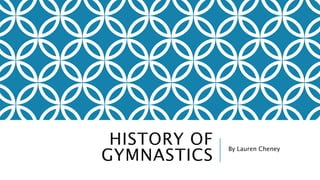
History of gymnastics
- 1. HISTORY OF GYMNASTICS By Lauren Cheney
- 2. WHAT IS GYMNASTICS? Gymnastics combines physical skills such as body control, coordination, flexibility, gracefulness, and strength with tumbling and acrobatic skills all performed in an artistic manner. The word gymnastics is derived from the ancient Greek word for disciplinary exercises. This activity is performed by both men and woman at all levels, from local clubs and universities to elite competitions such as the Opympics.
- 3. THE BEGINNING Gymnastics was introduced by the Greek civilization for the purpose of facilitating bodily development through physical activity such as running, jumping, swimming, throwing, wrestling, and even weight lifting. Many people actually used to practiced the developing sport in some form even before the Greek introduced their gymnazein which literally translates “to exercise naked”, which is exactly what they did.
- 4. ROUGH START After conquering Greece, the Romans turned their form of exercise into a more formal sport with the ideal purpose of their routines preparing participants for warfare. Although, when the threat of war was no longer so threatening, the popularity of the sport dwindled and tumbling stuck around only as a form of entertainment.
- 5. COMPETITION Gymnastics has existed for more than 2,000 years, but its development as a competitive sport began just a little more than 100 years ago. Men's gymnastics was first scheduled for the Olympic games in 1896, but Olympic gymnastic competitions for women did not start until 1936. The competition for women only included an all-around competition; female competitors had to wait until
- 6. For a long period of time, the sport of gymnastics was considered a strength sport for men and a grace sport for women. However, in 1972, that double standard changed when a Olga Korbut burst onto the gymnastic routine no one would have expected to see at the time. She was the first woman to combine strength and power with the grace changing the way people evaluated the competitors of
- 7. GYMNAST UNIFORMS The purpose of gymnastic uniforms have drastically changed. Women's leotards were originally intended to cover up as much of their body as possible, and as one can see in the picture above, men used to perform in pants! In today’s modern gymnastic competition, both men and women wear leotards. The uniforms in today’s gymnastics are meant to improve aerodynamics as well as bend with the competitor’s body as they move.
- 8. SCORING Gymnastic competitions are judged and scored on both individual and team performances. Each competitor must perform and execute a specific set of moves on each piece of equipment. Judges use a 0-10 scale. There are usually four judges and the highest and lowest scores are always dropped to provide a more objective evaluation.
- 9. NADIA COMANECI Nadia was the first female gymnast to be awarded with a perfect score of 10 in an Olympic gymnastics event. She also won two gold medals in the 1980 Summer Olympics.
- 10. SOURCES http://www.scholastic.com/teachers/article/history-gynastics-ancient- greece-modern-times https://usagym.org/pages/home/gymnastics101/history_artistic.htm l?prog=pb http://gymnastics.isport.com/gymnastics-guides/history-of-gymnastics